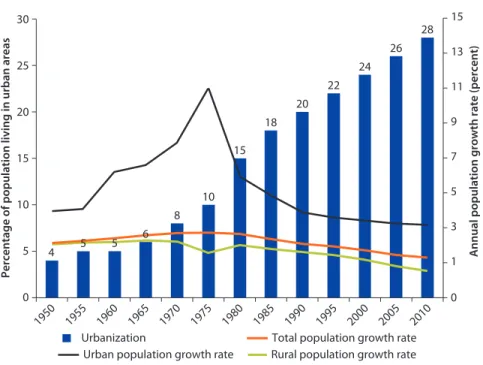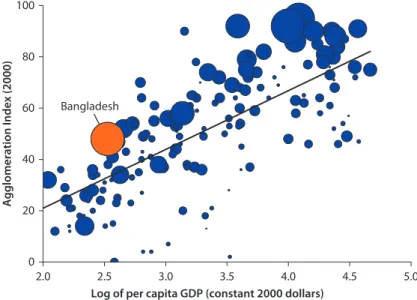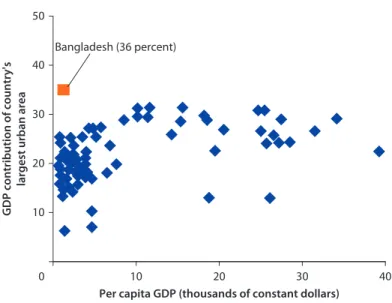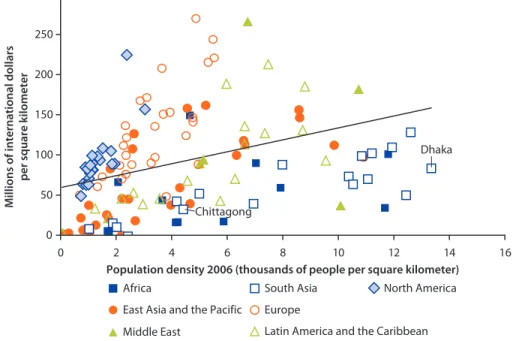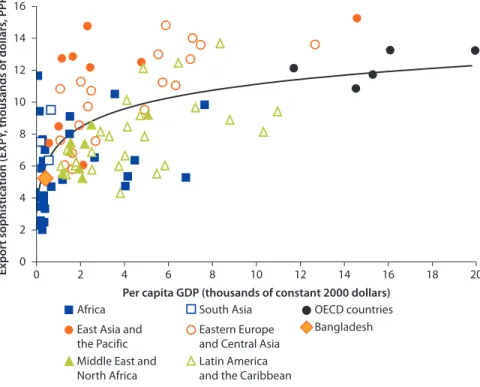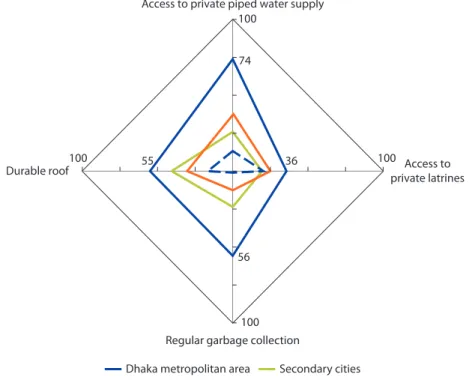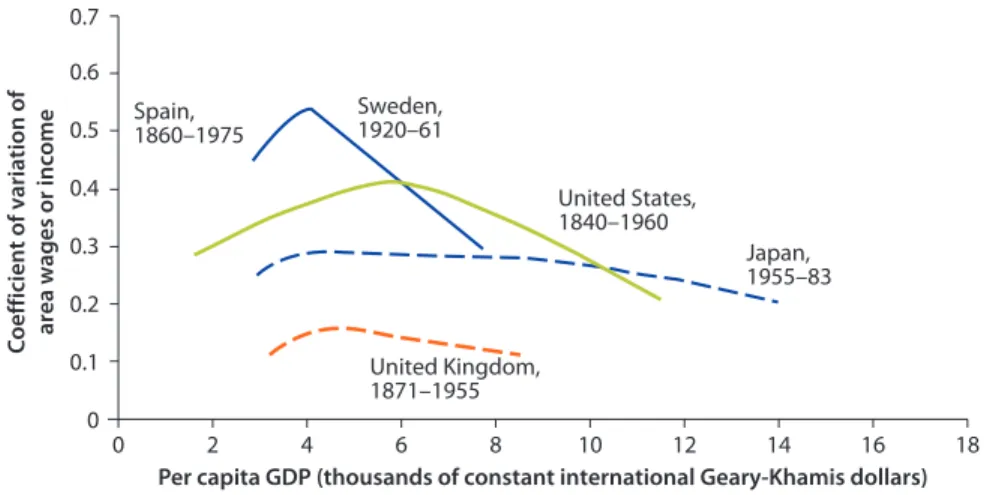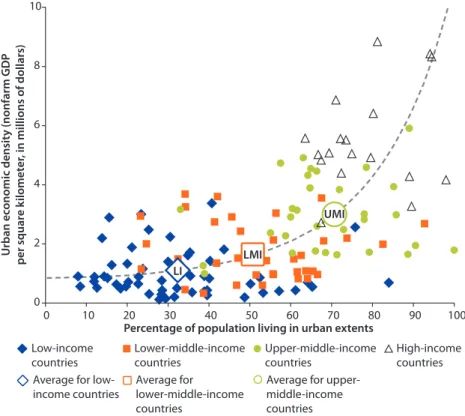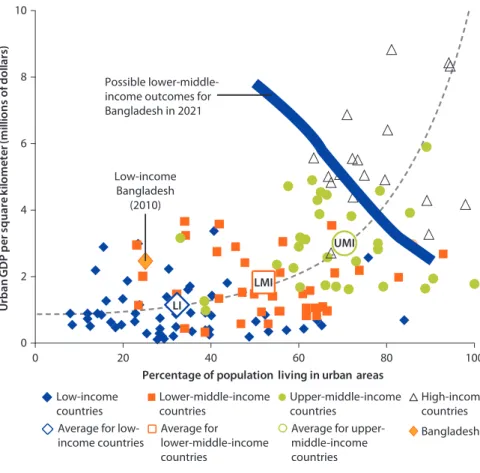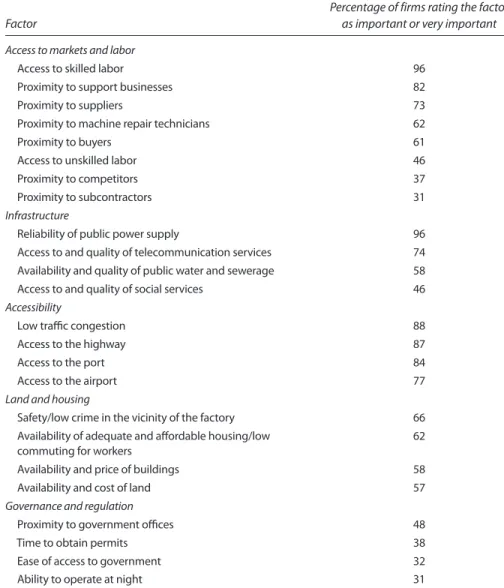Bangladesh
The Path to Middle-Income Status from an Urban Perspective
Elisa Muzzini and Gabriela Aparicio
Bangladesh
D I R E C T I O N S I N D E V E L O P M E N T Countries and Regions
Muzzini and Aparicio THE WORLD BANK
ISBN 978-0-8213-9859-3
SKU 19859
By 2021, the 50th anniversary of its independence, Bangladesh seeks to attain middle-income status. To accelerate growth enough to do so, Bangladesh needs to build a competitive urban space that is innovative, connected, and livable. Bangladesh: The Path to Middle-Income Status from an Urban Perspective investigates the drivers and obstacles to creating a competitive urban space by focusing on one of the country’s most successful industries: the garment sector.
In analyzing a survey of 1,000 garment firms, this study reveals that Bangladesh’s urban areas are falling behind in all the three drivers of competitiveness – innovation, connectivity, and livability. Dhaka City, its capital, is the country’s most productive location for garment firms. Yet, it is falling behind in accessibility and livability because of high congestion and severe constraints in its land and housing markets. And Dhaka City currently lacks the economic diversity that is expected in a metropolitan area of its size. Emerging manufacturing centers in the surrounding peri-urban areas suffer from Dhaka City’s congestion and their own low access to infrastructure. Chittagong City has failed to capitalize on its comparative advantage as the country’s largest seaport. And Bangladesh’s small and medium-size cities remain uncompetitive “distant places,” lacking the environment needed to foster local entrepreneurship.
To meet its goal of reaching middle-income status by 2021, Bangladesh will need to transform Dhaka into a globally-competitive metropolitan area, leverage Chittagong City’s seaport advantage, promote
strategically located export processing zones, and enable local economic development in small and medium-size cities. Bangladesh: The Path to Middle-Income Status from an Urban Perspective aims to foster timely policy dialogue among decision makers in the government, private sector, and civil society on the policy directions that will enhance the growth and sustainable development of Bangladesh’s cities.
C
Cities Wi Withoutut Slums
Cities Alliance
Public Disclosure AuthorizedPublic Disclosure AuthorizedPublic Disclosure AuthorizedPublic Disclosure AuthorizedPublic Disclosure AuthorizedPublic Disclosure AuthorizedPublic Disclosure AuthorizedPublic Disclosure Authorized
76187
Bangladesh
Bangladesh
The Path to Middle-Income Status from an Urban Perspective
Elisa Muzzini and Gabriela Aparicio
Countries and RegionsWashington DC 20433 Telephone: 202-473-1000 Internet: www.worldbank.org Some rights reserved 1 2 3 4 16 15 14 13
This work is a product of the staff of The World Bank with external contributions. Note that The World Bank does not necessarily own each component of the content included in the work. The World Bank therefore does not war- rant that the use of the content contained in the work will not infringe on the rights of third parties. The risk of claims resulting from such infringement rests solely with you.
The findings, interpretations, and conclusions expressed in this work do not necessarily reflect the views of The World Bank, its Board of Executive Directors, or the governments they represent. The World Bank does not guar- antee the accuracy of the data included in this work. The boundaries, colors, denominations, and other information shown on any map in this work do not imply any judgment on the part of The World Bank concerning the legal status of any territory or the endorsement or acceptance of such boundaries.
Nothing herein shall constitute or be considered to be a limitation upon or waiver of the privileges and immu- nities of The World Bank, all of which are specifically reserved.
Rights and Permissions
This work is available under the Creative Commons Attribution 3.0 Unported license (CC BY 3.0) http://
creativecommons.org/licenses/by/3.0. Under the Creative Commons Attribution license, you are free to copy, distribute, transmit, and adapt this work, including for commercial purposes, under the following conditions:
Attribution—Please cite the work as follows: Muzzini, Elisa, and Gabriela Aparicio. 2013. Bangladesh: The Path to Middle-Income Status from an Urban Perspective. Washington, DC: World Bank. doi:10.1596/978-0-8213- 9859-3. License: Creative Commons Attribution CC BY 3.0
Translations—If you create a translation of this work, please add the following disclaimer along with the attribu- tion: This translation was not created by The World Bank and should not be considered an official World Bank translation. The World Bank shall not be liable for any content or error in this translation.
All queries on rights and licenses should be addressed to the Office of the Publisher, The World Bank, 1818 H Street NW, Washington, DC 20433, USA; fax: 202-522-2625; e-mail: pubrights@worldbank.org.
ISBN (paper): 978-0-8213-9859-3 ISBN (electronic): 978-0-8213-9865-4 DOI: 10.1596/978-0-8213-9859-3
Cover photo: Selim Azad; Cover design: Naylor Design Library of Congress Cataloging-in-Publication Data
Muzzini, Elisa. Bangladesh : the path to middle-income status from an urban perspective / Elisa Muzzini and Gabriela Aparicio.
pages cm
Includes bibliographical references and index.
ISBN 978-0-8213-9859-3 (alk. paper)—ISBN 978-0-8213-9865-4 (electronic: alk. paper)
1. Urbanization—Bangladesh. 2. Urban policy—Bangladesh. 3. Economic development—Bangladesh.
4. Bangladesh—Economic conditions. I. Aparicio, Gabriela. II. World Bank. III. Title.
HT384.B3M89 2013 307.76095492—dc23
2013000719
v
Foreword xiii
Acknowledgments xv
Abbreviations xvii
Overview 1
Introduction 1 Bangladesh’s Urban Space Today: Implications for
the Growth Agenda 2
Envisioning the Future: A Competitive Urban Space
for Growth 3
Economic Growth Drivers in Urban Areas 5 Drivers of and Obstacles to Urban Competitiveness from
the Perspective of the Garment Sector 6 Strategic Directions for Building a Competitive Urban
Space in a Global Economy 8
References 9
Chapter 1 Introduction 11
The Path to Middle-Income Status from an Urban
Perspective 11 The Importance of a Competitive Urban Space for
Growth 12
Organization of the Study 12
Notes 14 References 14
Chapter 2 Bangladesh’s Urban Space Today: Implications forthe Growth Agenda 15
Introduction 15 Rapid Urbanization Accompanied by Strong Economic
Growth 16 Exceptionally High Population Density 19
Primacy of Dhaka 20
Concentrated Economic Production and Low Economic Density 22 Specialization in Low-Value-Added, Labor-Intensive
Garment Production 25
Peri-Urbanization of Garment Employment in
Metropolitan Dhaka 26
Extremely Poor Infrastructure, Low Level of Services,
and Lack of Amenities 29
Persistent, Albeit Declining, Regional Disparities in
Welfare 31 Benchmarking Bangladesh’s Urban Features 32 Notes 37 References 38
Chapter 3 Envisioning the Future: A Competitive Urban Space
for Growth 41
Introduction 41 Urbanization, Urban Economic Density, and GDP:
The Productivity Advantage of Urban Areas 42 A Bird’s Eye View of a Middle-Income Bangladesh:
“Taller Mountains” and “More Hills” 43 Bangladesh’s Journey to Middle-Income Status from an
International Perspective 44
Notes 48 References 48
Chapter 4 The Economic Growth Drivers of Urban Areas 51
Introduction 51
The Economic Base of Urban Areas 53
The Economic Geography of the Garment Sector 58 Notes 65 References 65
Chapter 5 Drivers of and Obstacles to Urban Competitiveness
from the Perspective of the Garment Sector 67
Introduction 67
Dhaka City 69
Peri-Urban Areas of Metropolitan Dhaka 78
Chittagong City 81
Export Processing Zones 84
Small and Medium-Size Cities 86
Notes 88
References 88
Chapter 6 Strategic Directions for Building a Competitive Urban
Space in a Global Economy 91
Introduction 91 A. Transform Dhaka into a Globally Competitive
Metropolitan Area 94
B. Leverage Chittagong’s Natural Comparative
Advantage as a Port City 100
C. Develop Strategically Located Export Processing Zones to Strengthen Competitiveness and Spearhead
Urban Reforms 101
D. Develop an Enabling Environment for Local Economic Development in Small and Medium-Size Cities 101 Note 103 References 103
Appendix A The Location Quotient and Shift-Share Analysis ofUrban Areas 105
Introduction 105 References 110
Appendix B Sampling Methodology and Key Findings ofthe Garment Firm Survey 111
Introduction 111
Sampling Methodology 111
Location Competitiveness 115
Boxes
1.1 Innovation, Connectivity, and Livability as the Drivers of
Urban Competitiveness 13
2.1 The Political Economy Advantage of Capital Cities 21 2.2 Deconcentrating Manufacturing in Brazil and Indonesia 29 3.1 Urbanization from an Economic Geographic Perspective 42
4.1 Defining Bangladesh’s Urban Space 52
4.2 The Strategically Located Urban Centers of Comilla,
Bogra, and Jessore 57
4.3 How Did the Garment Industry Come to Dominate
Bangladesh’s Economy 59
5.1 Agglomeration Forces and Peri-Urbanization in the
Manufacturing Sector 80
5.2 The Competitive Advantages of Coastal Cities 83 5.3 Policy Objectives and Achievements of Bangladesh’s Export
Processing Zones 86
6.1 One-Tier, Two-Tier, and Voluntary Cooperation Models of
Metropolitan Governance 95
6.2 Local Entrepreneurship and Innovation in Urban Areas 98 6.3 Regional Development Policies: What Works and
What Does Not 102
Figures
O.1 Two Paths to a Lower-Middle-Income Bangladesh 4 2.1 Urbanization and Economic Development in South Asia,
1960–2009 17 2.2 Urbanization and Annual Growth Rates of Total, Urban, and
Rural Population in Bangladesh, 1950–2010 17 2.3 Urbanization and per Capita Income, by Region, 2000 18 2.4 Composition of GDP in Bangladesh, 1990–2010 18 2.5 Cross-Country Correlation between Population Density,
Urbanization, and GDP, 2000 20
2.6 Urban Population in Largest Cities and per Capita GDP in
Selected Countries 21
2.7 Economic Geography of Bangladesh, 2009 22
2.8 Economic Concentration in Largest Cities and per Capita
GDP in Selected Countries 23
2.9 Population and Economic Density of Urban
Agglomerations, 2006 24
2.10 South Asia at Night: Economic Density Proxied by
Light Emission, 2005 24
2.11 Export Sophistication and per Capita GDP in Selected
Countries, 2006 25
2.12 Export Concentration in Selected Developing Countries,
1980–2006 26 2.13 Formal Garment Employment in the Dhaka Metropolitan Area,
2001–09 27 2.14 International Benchmarking of Infrastructure, Services, and
Amenities in Dhaka City, 2010 30
2.15 Share of Households with Access to Services and Housing, by
Urban Location, 2006 31
2.16 Regional Poverty Incidence in Bangladesh, 2000–10 34 2.17 Welfare Gap between Leading and Lagging Areas in Selected
Countries, 1995–2006 34
2.18 Historical Trends in Regional Inequality in Selected
High-Income Countries 35
3.1 Cross-Country Correlation between Urbanization, Urban
Economic Density, and GDP, 2000 43
3.2 Urban-Rural Disparities in Population Density, Productivity,
and Economic Density in Bangladesh, 2010 44
3.3 Two Paths to a Lower-Middle-Income Bangladesh 45
3.4 Dynamics of Two Paths to Lower-Middle-Income Bangladesh
by 2021 45
3.5 Rural Nonfarm Employment and Distance from Dhaka City 47 B4.1.1 Overlap between Alternative Urban Perspectives 53
4.1 Economic Base of Urban Areas, 2001–09 55
B4.2.1 Manufacturing Employment in Comilla, Bogra, and
Jessore by Sector, 2009 58
4.2 Garment Firms’ Ranking of Factors Affecting Choice of Location 64 5.1 Garment Firms’ Rating of Locations’ Performance Factors 68 5.2 Productivity Distribution of Garment Firms in Dhaka City 69 5.3 Reasons Why Garment Firm Managers Go to Dhaka City 70 5.4 Average Number of Hours Spent Traveling by Garment Firm
Managers to and from Business Meetings, by Location 72 5.5 Share of Visiting Time Spent Traveling by Garment Firm
Managers, by Location 72
5.6 Impact of Daytime Ban on Commercial Trucks in Dhaka
City on Garment Firms’ Delivery Costs and Time, by Location 73
5.7 Garment Firms’ Rent by Location 73
5.8 Land Intensity of Garment Production, by Location 73 5.9 Percentage of Garment Workers with Regular Access to
Power Supply, by Location 74
5.10 Percentage of Garment Workers with Regular Access to
Piped Water, by Location 74
5.11 People per Room in Garment Workers’ Housing, by Location 75 5.12 Turnover of Manufacturing Workers in Selected Asian
Countries, 2005 75
5.13 Urban-Related Inefficient Employee Turnover in Garment Firms,
by Location 76
5.14 Causes of Urban-Related Inefficient Employee Turnover in
Garment Firms, by Location 76
5.15 International Benchmarking of Living Conditions in Dhaka
City, 2010 77
5.16 Reasons Why Garment Firms Relocate from Dhaka City to
Peri-Urban Areas 79
B5.1.1 Life Cycle and Location Choice of High-Tech Firms in Tel
Aviv-Jaffa 80 5.17 Percentage of Garment Workers with Regular Garbage
Collection, by Location 81
5.18 Power and Water Outages Reported by Garment Firms,
by Location 82
5.19 Factors Affecting Order Lead Time in the Garment Industry 84 5.20 Export and Employment Performance of Bangladesh’s Export
Processing Zones, 2011–12 85
5.21 Relocation of Garment Firms 87
A.1 Location Quotient Analysis 106 A.2 Drivers of Local Employment Growth Identified by Shift-
Share Analysis, by Location, 2001–09 110
B.1 Distribution of Sampled Firms by Location 113 B.2 Distribution of Sampled Firms by Product 113 B.3 Perceptions of Location Performance and Rating of Importance
of Factors Affecting Firms’ Location Decisions, by Location 116 B.4 Comparison of Location Performance in the Factors Affecting
Firms’ Location Decisions 122
Maps
2.1 Population Density of Bangladesh, 2011 19
2.2 Employment Density of Garment Industry in Greater Dhaka
Metropolitan Area, 2009 28
2.3 Spatial Patterns of Manufacturing Employment in the
Republic of Korea, 1960–2005 28
2.4 Accessibility to Markets in Bangladesh, 2001 33 2.5 Regional Poverty Incidence in Bangladesh, 2005 33 3.1 Employment Density in Bangladesh’s Textile Sector, 2009 47 4.1 Spatial Distribution of Garment Employment in
Bangladesh, 2009 60
4.2 Clustering of Garment Firms in Dhaka Metropolitan
Area and Chittagong City 61
B.1 Sampling Areas in the Dhaka Metropolitan Area 112
Tables
2.1 Employment Density in Bangladesh’s Main Urban Areas,
2001–09 23 2.2 International Benchmarking of Features of Bangladesh’s
Urban Space 36
4.1 Values Garment Firms Assign to Factors Affecting Their
Location Decisions 63
5.1 Garment Firms’ Assessment of Disadvantages of Selected
Small and Medium-Size Cities 87
6.1 Policies and Actions to Improve the Competitiveness of
Bangladesh’s Urban Space 93
A.1 Sector Analysis for Urban Areas of Bangladesh, Based on
Location Quotient and Employment Growth, 2001–09 106 B.1 Characteristics of Surveyed Firms, by Location 114 B.2 Access to Markets and Labor: Location Performance Relative
to Dhaka City 125
B.3 Infrastructure: Location Performance Relative to Dhaka City 126
B.4 Accessibility: Location Performance Relative to Dhaka City 126
B.5 Land and Housing: Location Performance Relative to
Dhaka City 127
B.6 Governance and Regulation: Location Performance Relative
to Dhaka City 127
B.7 Summary Statistics for Productivity, Wages, and Rent,
fiscal 2008/09 129
B.8 Estimated Differences in Wage Bill and Rent, by Location 131
B.9 Estimated Total Factor Productivity Premiums, by Location 131
xiii
To meet its goal of reaching middle-income status by 2021, the 50th anniversary of its independence, Bangladesh needs to accelerate growth from its current rate of 6 percent to more than 8 percent a year. Accelerating growth will inevitably require a significant urban transformation, as urbanization and economic growth occur in tandem. Indeed, no country has ever reached middle-income status without urbanizing.
Strong economic growth has sustained and fueled urbanization in Bangladesh.
But the urban transition is not yet yielding all of its potential economic benefits.
The economic, social, and environmental costs of unmanaged urban develop- ment—slums, traffic, crime—are increasing. Failure to address them could pre- vent Bangladesh from meeting its goal.
The study presents new and robust empirical evidence on the drivers of and constraints to urban competitiveness through the lens of the garment sector—an industry that has thrived in Bangladesh’s urban areas. It does so by presenting the results of a survey of 1,000 garment firms carried out across six locations in Dhaka and Chittagong. The study finds that, to accelerate growth, Bangladesh needs cities that are more capable of innovating, better connected internally and with the global economy, and more livable.
The study strengthens the knowledge base for understanding the economic and spatial dynamics of urbanization in Bangladesh. It helps decision makers think through the costs and benefits of policies intended to spur growth and achieve sustainable development of Bangladesh’s cities. I hope it will foster timely dialogue on the urban policy directions that will best support Bangladesh’s aspiration to reach middle-income country status by 2021.
Salman Zaheer
Acting Country Director for Bangladesh and Nepal
xv
This study was prepared by a team led by Elisa Muzzini, senior economist in the South Asia Urban and Water Unit, and included Gabriela Aparicio, Pedro Amaral, Richard Clifford, Mario Di Filippo, Wietze Lindeboom, Viviana Mora, and Mark Roberts. The study was carried out as part of the preparation of the Bangladesh Growth Report Bangladesh: Towards Accelerated, Inclusive and Sustainable Growth—Opportunities and Challenges, led by Lalita Moorty and Zahid Hussain, who provided valuable guidance and inputs to the team. The study was conducted under the overall direction of Ming Zhang (sector man- ager, South Asia Urban and Water Unit) and Ellen Goldstein (formerly coun- try director for Bangladesh and Nepal). Valuable comments and inputs were received from Shihab Azhar, Songsu Choi, Thomas Farole, Steve Karam, Sanjay Kathuria, Zhaed Khan, Andras Horvai, Bill Kingdom, Bala Menon, Martin Norman, Bernice Van Bronkhorst, Tony Venables, and the participants of the consultative workshops for the Bangladesh Growth Report, in particu- lar Dr. Hossain Zillur Rahman (executive chairman, Power and Participation Research Center, Dhaka); Prof. Nazrul Islam (chair, Centre for Urban Studies, Dhaka); and Prof. Wahiduddin Mahmud (chair, Economic Research Group, Dhaka). The garment firm survey for the study was conducted by NIELSEN (Dhaka), with support from Wietze Lindeboom and Nadeem Rizwan. The Bangladesh Bureau of Statistics (BBS), the Bangladesh Garments Manufacturers and Exporters Associations (BGMEA), the Bangladesh Knitwear Manufactures and Exporters Association (BKMEA), and the Bangladesh Export Processing Zones Authority (BEPZA) provided guidance and support to the survey team.
Barbara Karni edited the report. The study was jointly funded by the World
Bank, the World Bank–AusAID Policy Facility for Decentralization and
Service Delivery, and Cities Alliance.
xvii
BEPZA Bangladesh Export Processing Zones Authority
BGMEA Bangladesh Garments Manufacturers and Exporters Association BKMEA Bangladesh Knitwear Manufacturers and Exporters Association EIU Economic Intelligence Unit
EPZ export processing zone
GATT General Agreement on Tariffs and Trade GDP gross domestic product
GNI gross national income
GRUMP Global Rural-Urban Mapping Project ICT information and communications technology LQ location quotient
MFA Multi-Fiber Agreement
NOAA National Oceanic and Atmospheric Administration
OECD Organisation for Economic Co-operation and Development PPP purchasing power parity
R&D research and development
SMA Statistical Metropolitan Area
TFP total factor productivity
Tk Bangladesh taka
1
Bangladesh needs to build a competitive urban space that is innovative, con- nected, and livable to reach middle-income status by 2021. Bangladesh cannot reach middle-income status without a competitive Dhaka, the engine of its growth.
The results of a survey of 1,000 garment firms—conducted to provide a lens through which to investigate urban competitiveness—reveal that Dhaka City is the most productive location for garment firms in Bangladesh. It is falling behind in accessibility and livability because of high congestion and severe constraints in land and housing markets, however. And it needs to gain a competitive edge in higher-value-added products and services. Peri-urban areas of metropolitan Dhaka are emerging as competitive manufacturing centers, but they suffer from Dhaka City’s congestion and have less access to infrastructure. Chittagong City has failed to capitalize on its comparative advantage as the country’s largest sea- port city. Strategically located export processing zones (EPZs) are partially shielded from the inefficiencies of urban areas. Small and medium-size cities need to foster local entrepreneurship to find their comparative advantages. Strengthening competitiveness across Bangladesh’s cities calls for coordinated and multipronged interventions to transform Dhaka into a globally competitive metropolitan area, leverage Chittagong City’s natural comparative advantage as a port city, promote strategically located EPZs, and create the enabling environment for local economic development in small and medium-size cities.
Introduction
Bangladesh seeks to attain middle-income status by 2021, the 50th anniversary of its independence. To accelerate growth enough to do so, it will need to undergo a structural transformation that will change the geography of economic produc- tion and urbanization. Critical to its transformation will be the creation of a globally competitive urban space—defined here as a space that has the capacity to innovate, is well connected internally and to external markets, and is livable (OECD 2006; World Bank 2010).
Overview
This study identifies what is unique about Bangladesh’s process of urban- ization and examines the implications for economic growth. Through the lens of Bangladesh’s most successful industry, the garment sector, it describes the drivers of and constraints to urban competitiveness. Based on the find- ings, it provides policy directions to strengthen the competitiveness of Bangladesh’s urban space in ways that will allow Bangladesh to reach middle- income status by 2021.
Bangladesh’s Urban Space Today: Implications for the Growth Agenda
Bangladesh’s urban space has exceptionally high population density but rela- tively low economic density. Excluding city-states and small islands, it has the highest population density in the world (1,015 people per square kilometer);
Dhaka City is one of the most densely populated cities in the world. High popu- lation density, combined with rapid urbanization, implies a large and rapidly growing urban population. In contrast, the economic density of Bangladesh’s urban areas is relatively low from an international perspective. Even in Dhaka, output falls short of what would be expected for a city of comparable population density.
With an estimated population of 15 million, metropolitan Dhaka is a primate city (a city that is at least twice as large as the country’s second-largest city) with roughly three times the population of metropolitan Chittagong. For decades researchers have been debating whether Dhaka is too large and what drives the primacy of capital cities. Concern over the size of primate cities is often mis- placed: the issue is not whether a primate city is too large but rather how well it is managed. The concentration of the urban population in metropolitan Dhaka (36 percent) is broadly in line with countries at similar levels of economic devel- opment. And international experience indicates that population concentration tends to increase as countries develop and urbanize, before it levels off.
Output from Dhaka and Chittagong dominates Bangladesh’s economic land-
scape (figure O.1a). About 10 percent of Bangladesh’s population lives in the
Dhaka metropolitan area, which generates 36 percent of national gross domestic
product (GDP). The Chittagong metropolitan area—home to 3 percent of the
population—contributes another 11 percent. The gap between Dhaka and
Chittagong on the one hand and small and medium-size cities (including sec-
ondary cities and municipalities [pourashava]) on the other is large and widen-
ing, as most small and medium-size cities have a narrow economic base and
have yet to find their competitive advantages. Economic concentration in
Bangladesh, measured as the GDP of the country’s densest area as a percentage
of total GDP (36 percent), is slightly above the level expected for countries at
similar levels of economic development. But international experience shows that
economic activities agglomerate as a country develops.
Bangladesh’s manufacturing sector specializes in export-oriented, low- value-added garment production. Garments are Bangladesh’s biggest economic success story. The industry was born and has thrived in Bangladesh’s two larg- est agglomerations. Specialization of industrial production and exports earning is not uncommon for low-income countries, and Bangladesh’s export sophisti- cation is in line with its economic development. As international experience shows, concentration of industrial production in the largest cities is also com- mon at the initial stages of the urban transition.
Although still concentrated in Dhaka City, garment production is sprawling to peri-urban areas. As urbanization intensifies, the cost of producing in core urban areas increases; services usually replace urban factories and workshops, which gradually move to peri-urban areas. Growth of peri-urban areas of met- ropolitan Dhaka is in line with the experience of rapidly urbanizing countries like Brazil, Indonesia, and the Republic of Korea. Despite the growing economic importance of such areas, however, no institutional mechanism exists for coor- dination between the Dhaka core and the periphery at the metropolitan level.
Garment production benefits from Bangladesh’s labor-abundant urban agglomerations. But urban infrastructure and services have lagged behind. So poor is the quality of infrastructure, services, and amenities that the Economic Intelligence Unit (EIU)’s annual ranking of 140 cities worldwide places Dhaka among the world’s 10 worst cities (EIU 2010).
Bangladesh’s urban features—exceptionally high population and extremely poor infrastructure and services—have implications that matter for growth. High population density demands high economic density (GDP or value added per square kilometer) if Bangladesh is to reach the per capita income of a lower- middle-income country. Poor infrastructure and services are a constraint for the competitiveness of urban areas, negatively affecting the productivity, connectiv- ity, and livability of the urban space.
Bangladesh’s spatial concentration of economic production and specialization in low-value-added garments are broadly in line with international experience, yet they have important implications for the journey to middle-income status.
Bangladesh cannot reach middle-income status without a competitive Dhaka, given its economic importance for the country. Specialization in low-value-added garments has served Bangladesh well to date—but it is a constraint for the transi- tion to middle-income status. As international experience shows, countries do not reach middle-income status until they diversify and increase the sophistica- tion of their exports.
Envisioning the Future: A Competitive Urban Space for Growth
Bangladesh needs to accelerate annual economic growth from 6 to 8 percent if it is to become a lower-middle-income country by 2021 (World Bank 2012).
A cross-country analysis shows that countries experience an increase in the
economic density of urban areas and further urbanize as they transition to middle-income status.
A scenario analysis shows that from an economic geography perspective, Bangladesh needs “taller mountains” (greater economic density in its largest met- ropolitan areas) and “more hills” (broader urbanization) to reach lower-middle- income country status. First, it needs to make its “economic mountains taller”—
that is, increase economic density in its largest metropolitan areas. Doing so requires shifting toward a higher-value-added industrial and service mix in Dhaka and Chittagong. Second, Bangladesh needs to create “more hills,” by increasing the percentage of the population engaged in nonfarm employment. Figure O.1b shows two economic geography scenarios for a lower-middle-income Bangladesh.
Scenario A emphasizes the path of increased economic density (higher-value- added production in Dhaka and Chittagong). Scenario B emphasizes the path of urbanization (nonfarm diversification outside the two main cities).
Given its exceptionally high population density, Bangladesh has to increase the economic density of its urban areas and urbanize even more forcefully than did countries that have already undergone this transformation. Even if Bangladesh reaches a level of urbanization in line with other lower-middle-income countries (52 percent), it would still require urban economic density four times as high as the average lower-middle-income country.
This finding has important implications for Bangladesh’s growth agenda. It suggests that Bangladesh needs a competitive urban space to accelerate growth. Only competitive urban areas can sustain the high economic density that Bangladesh needs to reach lower-middle-income status. The finding also indicates that Bangladesh cannot accelerate growth without “making Dhaka’s economic mountain taller.” Doing so requires diversifying the area’s economic base and moving toward a higher-value-added industrial and service mix.
Figure O.1 Two Paths to a Lower-Middle-Income Bangladesh
Source: Based on data from Bangladesh Bureau of Statistics 2009.
Scenario A: Higher- value-added production
a. Bangladesh in 2009 b. Bangladesh as a lower-middle-income country, two scenarios
Scenario B: Greater nonfarm diversification
Economic Growth Drivers in Urban Areas
Dhaka City is an important garment production center, but it is losing competi- tiveness to peri-urban areas—and as garment production peri-urbanizes, there is limited evidence of replacement industries emerging to ensure continued urban vitality in Dhaka City. The peri-urban areas of metropolitan Dhaka are emerging as competitive garment production centers, and the contribution of peri-urban areas to garment production is increasing rapidly.
Chittagong City has a highly specialized and growing industrial base. About 84 percent of formal employment is in the manufacturing sector. The garment industry is the largest and most important source of employment. Unlike in met- ropolitan Dhaka, where peri-urban areas play an increasingly important role, garment employment in Chittagong is still concentrated in the city proper; the industry is virtually absent in peri-urban areas. The city’s peri-urban areas have a narrow but growing industrial base, with a competitive advantage in the manu- facture of cotton textiles.
Secondary cities (that is, the metropolitan areas and city corporations, which are the higher tier of urban local governments, other than Dhaka and Chittagong) have yet to find their competitive advantages. They are service-based economies, with a narrow and declining industrial base. The garment industry is virtually absent in these cities. The largest industrial clusters—jute, fabricated metals, and chemicals—are growing at a slower rate than the national average. Agro- processing is a potential emerging cluster.
Nonmetropolitan municipalities have a small but expanding manufactur- ing base, with a competitive advantage in cotton textiles. The garment indus- try is of minor importance. Comilla, which gained city corporation status in 2011, has traditionally had one of the most vibrant urban bases, largely because of its strategic location on the Dhaka-Chittagong corridor. It has a large cluster of footwear manufacturers. Together with Bogra and Jessore (two other strategically located urban centers), it also has clusters of ceramic manufacturers.
The garment sector is the main driver of economic growth in urban areas. It has been highly successful in increasing economic density since the first garment firm was established, in Chittagong in 1977. It is Bangladesh’s largest export industry, accounting for 40 percent of formal industrial employment. The industry is pre- dominantly in urban (including peri-urban) areas, which account for 93 percent of formal garment sector jobs. Bangladesh’s main garment production centers are Dhaka City, the peri-urban areas of metropolitan Dhaka, and Chittagong City.
The survey of garment firms carried out for this study shows that forces pro-
moting agglomeration of garment production prevail, although traffic congestion
and the high cost of land and housing are emerging forces promoting dispersion
of garment production. When choosing their location, garment firms value access
to skilled labor and access to power supply the most, followed by access to the
highway and port, proximity to support businesses, availability of telecommuni-
cations, and access to the airport. All of these factors draw firms to cities. Traffic
congestion and the high cost of land and housing work against agglomeration forces to promote dispersion of economic activities to lower-cost locations.
Drivers of and Obstacles to Urban Competitiveness from the Perspective of the Garment Sector
The survey of garment firms conducted as part of the study provides a lens through which to investigate urban competitiveness. Concentrated largely in urban areas, Bangladesh’s garment sector provides a large enough sample to allow comparison of competitiveness across urban locations. The survey of garment survey is representative of six locations where garment production is concen- trated: Dhaka City, urban peri-urban areas of metropolitan Dhaka, rural peri- urban areas of metropolitan Dhaka, the Dhaka EPZ, Chittagong City, and the Chittagong EPZ. The survey of garment firms reveals significant variation in competitiveness across the surveyed locations.
Dhaka City
Dhaka City is the most productive location for garment firms in Bangladesh. It has a total factor productivity premium over both Chittagong City and peri- urban areas of metropolitan Dhaka in garment production. It is the best- performing city location in Bangladesh for access to skilled labor and power supply (the two factors garment firms value the most when selecting their loca- tions) as well as proximity to suppliers, subcontractors, machine repair techni- cians, and support businesses.
It is falling behind other locations in accessibility, however—and for some firms, the costs of operating in Dhaka City have started to outweigh the benefits.
Dhaka City is the worst-performing location for urban mobility and access to the highway. Compared with firms in Chittagong City, firms in Dhaka City also have a disadvantage in accessing the port and the airport. Firms and workers alike in Dhaka suffer from the limited availability and high prices of land and housing.
The high productivity of the garment workforce in Dhaka City has not led to better living conditions for production workers, who live in a deteriorating urban environment characterized by overcrowding and lack of amenities. These work- ers have significantly less access to housing and services than the average Dhaka urban dweller. The share of urban-related inefficient worker turnover (defined as separations caused by urban inefficiency rather than by more competitive job offers) is higher in Dhaka City than elsewhere in Bangladesh. Workers in Dhaka City cite the housing shortage as the main reason for urban-related separations, followed by the high cost of living. Inadequate access to land and transport infra- structure is the leading cause of firm relocation to peri-urban areas.
Peri-Urban Areas of Metropolitan Dhaka
The birth of new garment firms, rather than the relocation of existing firms, is
driving peri-urbanization. Understanding the causes of relocation can neverthe-
less shed light on the main drivers of peri-urbanization.
About half of the firms that relocated from Dhaka City to peri-urban areas cite a desire to gain better access to transport infrastructure and avoid Dhaka’s congestion as the primary reason for relocating. Another 25 percent relocated because of high costs and the limited availability of land, buildings, and housing in Dhaka City.
Peri-urbanization is associated with the growth of a more competitive, verti- cally integrated business model in the garment sector. Peri-urban garment firms are more land intensive and more likely to be vertically integrated than garment firms in Dhaka City, suggesting that younger firms are opting for a consolidated, vertically integrated business model, which has significant advantages for inter- national competitiveness. Vertically integrated firms have statistically signifi- cantly lower lead times than the average garment firm and are therefore better equipped to compete internationally.
Peri-urban areas benefit from proximity to Dhaka City, and they have a com- parative advantage in accessibility, land, and housing. But they suffer from Dhaka City’s congestion and have less access to infrastructure than the city proper.
Peripheral municipalities perform as well as Dhaka City in access to skilled labor, suggesting that they benefit from proximity to Dhaka City. However, peripheral rural areas are less competitive than Dhaka City in access to markets, including buyers, suppliers, subcontractors, competitors, and support businesses.
Chittagong City
Chittagong City is a lower-productivity, lower-cost location for garment firms relative to Dhaka. Chittagong is less competitive than Dhaka in access to markets, in particular access to skilled labor (the factor garment firms value the most), suppliers, and support businesses. But it has a cost advantage in land and housing and accessibility. Garment firms rank Chittagong City the best-performing location for the availability and cost of land, buildings, and housing for workers.
They also rate it as the top location for access to the port, airport, and highway and urban mobility.
Despite its accessibility advantage, Chittagong has not been able to capital- ize on its comparative advantage as the largest seaport city in Bangladesh, as it is one of the most inefficient ports in Asia. The port handles 80–85 percent of Bangladesh’s foreign trade, including the bulk of its main export (gar- ments). Its slow turnaround times hamper exports, in particular garments. The Chittagong port is cited as the main factor negatively affecting lead times in the industry, which are as much as twice as long as competitors (88 days among the surveyed firms against 40–60 days in China and 50–70 days in India) (Haider 2007). Half of the firms surveyed cite the time it takes to unload at port as the main bottleneck, and another 30 percent cite the time required to obtain port clearance.
Export Processing Zones
EPZs in Bangladesh are higher-productivity, higher-cost locations that are par-
tially shielded from the inefficiencies of Dhaka and Chittagong. Wages and
building rents are higher in EPZs. The cost differential suggests that the attrac- tiveness of EPZs is interacting with constraints on the supply side to bid up wages and rents.
Among the surveyed locations, the Chittagong EPZ is the best-performing location and the only one with satisfactory performance across all locations fac- tors, including access to power supply. Unlike the very successful EPZs in Dhaka and Chittagong, the EPZs located in locations distant from Dhaka and Chittagong have not succeeded in attracting garment firms.
Small and Medium-Size Cities
Garment firms perceive small and medium-size cities as uncompetitive “distant places.” Garment firms cite poor access to markets, in particular skilled labor, as the main disadvantage in these cities.
Small and medium-size cities need to develop a competitive advantage by relying on local entrepreneurship rather than by attempting to attract firms from elsewhere through relocation incentives. A major reason why these cities have not been able to attract garment firms is that only 10 percent of the sampled firms relocated at all—and among firms that did, no firms moved to another city.
Rather than attempt to attract firms from elsewhere, small and medium-size cit- ies in Bangladesh need to foster local entrepreneurship to find their comparative advantages.
Strategic Directions for Building a Competitive Urban Space in a Global Economy
Bangladesh needs to build a competitive urban space to accelerate growth if it is to attain middle-income status by 2021. The country’s urban areas have to take proactive measures to improve and sustain all three drivers of competitiveness:
innovation, connectivity, and livability.
• The Dhaka metropolitan area needs to evolve into a diversified economy with highly skilled human resources and an innovation capacity fueled by the cross- fertilization of ideas that characterizes large metropolitan areas. It also needs to be better connected internally and with its peri-urban areas.
• Both Dhaka and Chittagong have to strengthen their connection to the global economy. Improved connectivity within Bangladesh’s system of cities—in par- ticular along the Dhaka-Chittagong corridor—is also important for increasing productivity and export competitiveness.
• The development of an economically dynamic urban space, in particular in
the Dhaka metropolitan area, has occurred at the expense of livability. As
Bangladesh transitions to a new economic model based on higher-value-added
industries and services, requiring a highly skilled and internationally mobile
workforce, livability will become increasingly important.
Strengthening competitiveness across the entire spectrum of cities calls for coor- dinated and multipronged interventions encompassing infrastructure, institu- tions, and incentives, in line with the following strategic directions:
• Transform Dhaka into a globally competitive metropolitan area, by developing appropriate institutional mechanisms for core-periphery coordination in the Dhaka metropolitan area; improving infrastructure to leverage Dhaka’s pro- ductivity advantage while enhancing accessibility to manage the growing dis- economies of agglomeration; and upgrading peripheral infrastructure in order to transform peri-urban areas into globally competitive manufacturing centers. In parallel, priority should be given to strengthening institutions to create a more efficient and integrated land and housing market; enhance the coordinating role of local authorities to foster a business environment that rewards entrepreneurship and innovation in the metropolitan area; and improve livability and amenities to make urban growth in Dhaka more envi- ronmentally and socially sustainable.
• Leverage Chittagong City’s natural comparative advantage as a port city by expanding the capacity and improving the operational effectiveness of its port.
Investments in institutions and infrastructure are also needed to sustain Chittagong City’s advantage as a lower-cost location as the city expands.
• Promote strategically located EPZs—near markets and in line with locations’
comparative advantages—to foster industry competitiveness and spearhead urban reforms. Rather than fighting agglomeration forces by developing zones in “distant” locations, Bangladesh’s growth strategy should include the develop- ment of a coherent EPZ policy based on a transparent set of criteria for deter- mining locations.
• Create an enabling environment for local economic development in small and medium-size cities. The priority is to connect them to markets and create a level playing field in the provision of basic services across locations in order to improve livability and promote local entrepreneurship.
References
Bangladesh Bureau of Statistics. 2009. Economic Census. Dhaka.
EIU (Economic Intelligence Unit). 2010. Liveability Ranking Report. London.
Haider, Mohammed. 2007. “Competitiveness of the Bangladesh Ready-Made Garment Industry in Major International Markets.” Asia-Pacific Trade and Investment Review 3 (1): 3–27.
OECD (Organisation for Economic Co-operation and Development). 2006. Competitive Cities in the Global Economy. OECD Territorial Review. Paris: OECD.
World Bank. 2010. Competitiveness and Growth in Brazilian Cities: Local Policies and Actions for Innovation. Washington, DC: World Bank.
———. 2012. “Bangladesh: Toward Accelerated, Inclusive and Sustainable Growth: An Overview.” Poverty Reduction and Economic Management Sector Unit, Washington, DC: World Bank.
11
Bangladesh needs a competitive urban space to accelerate growth and reach middle- income status by 2021. The study focuses on the economic dimension of the urban transition in Bangladesh and its implications for the growth agenda. It assesses the drivers and obstacles of urban competitiveness from a private sector perspective, and discusses policy directions on how urban areas can leverage their comparative advan- tages and address their competitiveness constraints to accelerate growth.
The Path to Middle-Income Status from an Urban Perspective
This study presents Bangladesh’s path to middle-income status from an urban perspective. Countries that have reached middle-income status have done so by shifting from agriculture to manufacturing and services, diversifying their output, increasing their export product sophistication, and urbanizing.
1Manufacturing and service firms often locate close to urban areas in order to capture the pro- ductivity advantages generated by agglomeration economies—such as access to markets, including a large labor market, and knowledge spillovers. The productiv- ity advantages of cities are magnified in developing countries, where transporta- tion and communication costs are highest.
The urban agenda is an essential part of the growth agenda in Bangladesh, where urbanization and economic growth have been strongly correlated since the 1980s. Urban areas produce about 60 percent of the country’s gross domestic product (GDP) (UNICEF 2010), with the Dhaka metropolitan area alone—
Bangladesh’s largest urban center—generating 36 percent of total output. The focus of the study is on the economic dimension of the urban transition and its implications for the growth agenda. The study defines urbanization based on the agglomeration of economic activities, as measured by economic density (GDP or value added per square kilometer) rather than the agglomeration of people, because it is the agglomeration of economic activities that allows for the produc- tivity gains associated with urbanization to materialize.
The study focuses on the linkages between the urban and growth agenda;
assessment of the role of rural areas for economic growth is beyond its scope. The
Introduction
study does not discuss the welfare implications associated with high and sus- tained economic growth in urban areas. A separate study of the assessment of the redistributive policies needed to reduce welfare disparities between leading and lagging regions and between urban and rural areas should complement it.
The Importance of a Competitive Urban Space for Growth
Bangladesh needs a competitive urban space to reach middle-income status. The study defines a competitive urban space as a space that is innovative, connected, and livable. Competitiveness captures a city’s comparative advantage in attract- ing mobile production factors and its ability to leverage these advantages to sustain growth. International empirical evidence suggests that cities that have high innovation levels, are globally connected, and have a livable and high-quality environment are economically successful, because they are attractive locations for firms and workers (box 1.1).
This study assesses the drivers and obstacles of urban competitiveness from a private sector perspective. It presents original evidence on urban competitiveness based on the results of a survey of 1,000 garment firms carried out in 2011. The study is not about the garment sector per se. The sector is the lens through which the competitiveness of urban areas in Bangladesh is viewed. The lessons learned and policy directions emerging from the analysis can shed light on how to create a better urban environment benefiting not only the garment sector but other urban-based sectors as well.
Concentrated largely in urban areas, Bangladesh’s garment sector provides a large enough sample to allow comparison of competitiveness across urban loca- tions and to assess the impact of the local environment on firm competitiveness.
2The sample of firms is therefore stratified by location. The survey is representa- tive of six locations: Dhaka City, urban peri-urban areas of metropolitan Dhaka, rural peri-urban areas of metropolitan Dhaka, the Dhaka export processing zone (EPZ), Chittagong City, and the Chittagong EPZ. The sampling frame was selected in a way that ensured adequate coverage of small, medium, and large-size firms as well producers of both knitwear and woven (or ready-made) garments.
Organization of the Study
This study is structured as follows. Chapter 2 analyzes the main features of
Bangladesh’s urban space today and compares them with international experi-
ence in order to examine what is unique about its process of urbanization and
to identify the implications for the growth agenda. Chapter 3 highlights the
importance of a competitive urban space for growth by providing a bird’s eye
view of the geography of economic production of a middle-income Bangladesh
based on a scenario analysis. Chapter 4 assesses competitiveness from a city-
level perspective by identifying the growth drivers and comparative advan-
tages of the urban areas comprising Bangladesh’s urban hierarchy. It then
delves into the garment sector—a thriving, urban-based, export-oriented
Box 1.1 Innovation, Connectivity, and Livability as the Drivers of Urban Competitiveness
Competitive cities have high innovation levels, are internally and globally connected, and have livable and high-quality environments. Market forces drive economic dynamism and competitiveness, but public policy has to deal with the urban externalities that affect innovation, connectivity, and livability, such as congestion, slum formation, and environmental degradation.
Innovation
Because innovation emerges through market forces, the knowledge spillovers that foster innovation are eas- ier to capture within the urban space. More than 81 percent of patents—an important indicator of innovation activities—are filed by applicants in urban areas in Organisation for Economic Co-operation and Develop- ment (OECD) countries. Paris and London alone account for more than 40 percent of their countries’ total patent applications (OECD 2006). The economic exploitation of innovative knowledge depends not only on the skill mix of the local workforce but also on knowledge exchanges by universities, research centers, and business communities. Cities have a role to play in identifying educational needs, providing incentives to meet them, and brokering exchanges between universities and the business community to foster innovation. Skill upgrading and knowledge exchanges are important for nurturing the competitiveness of existing specialized clusters and facilitating new business growth and product development (World Bank 2010).
Connectivity
The advantage of proximity fosters competitiveness. Successful cities have better accessibility: they are con- nected internally through an efficient road network and public transport system, as well as externally, to the global economy. Firms located in well-connected cities find it easier to access networks of resources, including labor and components of the supply chain. Transportation and communication networks multiply interfirm linkages among cities, including flows of goods, people, and ideas, creating an integrated system of cities.
Livability
A livable city is a competitive city, especially in a rapidly changing global economy characterized by increas- ingly mobile human resources. There is no trade-off between economic dynamism and livability. On the contrary, international evidence indicates a strong association between economically vibrant cities and a high-quality environment. Firms in advanced sectors compete for high-skilled workers, who want to live in an attractive environment with good services and amenities. Livability calls for proactive public policies, as a high-quality city environment is very expensive to restore once problems develop. Slums, for example, are difficult to eradicate without massive disruption to people’s lives.
Sources: OECD 2006; World Bank 2010.
industry—and its economic geography. Chapter 5 compares the drivers of and
obstacles to urban competitiveness across locations through the lens of the
garment sector. Chapter 6 discusses policy directions on how urban areas can
leverage their comparative advantages and address their competitiveness con-
straints to accelerate growth. The full results of the analysis are presented in
the appendixes. Appendix A presents the results of the diagnostic assessment
of the economic base and cluster composition of Bangladesh’s urban areas
based on location quotient and shift-share analysis techniques. Appendix B
presents the quantitative analysis of the 2011 garment survey. It describes the sampling strategy and survey methodology and presents regression results of the location competitiveness and productivity analysis.
Notes
1. Urbanization explains 55 percent of regional variation in GDP per capita, although the relation does not imply causality (Buckley and others 2009).
2. The analysis is not a full competitiveness assessment of the garment sector, as industry- specific factors affecting firms’ competitiveness are outside the scope of the study.
References
Buckley, Robert M., Patricia Clarke Annez, andMichael Spence, eds. 2009. Urbanization and Growth. Washington, DC: Commission on Growth and Development, World Bank.
OECD (Organisation for Economic Co-operation and Development). 2006. Competitive Cities in the Global Economy. OECD Territorial Review. Paris: OECD.
UNICEF (United Nations Children’s Fund). 2010. Understanding Urban Inequalities in Bangladesh: A Pre-requisite for Achieving Vision 2021. Dhaka: UNICEF.
World Bank. 2010. Competitiveness and Growth in Brazilian Cities: Local Policies and Actions for Innovation, edited by Ming Zing. Directions in Development. Washington, DC: World Bank.
15
Bangladesh’s urban space is characterized by extraordinarily high population density, relatively low economic density, and extremely poor infrastructure and services. If Bangladesh is to grow enough to attain middle-income status, it needs high economic density (gross domestic product [GDP] or value added per square kilometer) to sup- port its high population density. To increase the productivity, connectivity, and livabil- ity of urban areas, it also needs better urban infrastructure and services. Given the economic importance of its capital city, Bangladesh cannot reach middle-income sta- tus without a competitive Dhaka, the engine of its growth. Specialization in low-value- added garments has served Bangladesh well, but international experience shows that countries do not reach middle-income status until they diversify and increase the sophistication of their exports.
Introduction
Bangladesh’s process of urbanization presents distinct features. The chapter reviews the main characteristics of Bangladesh’s urban space and benchmarks them against international experience to identify what is unique about the coun- try’s process of urbanization. Eight main features characterize Bangladesh’s urban space today:
• rapid urbanization accompanied by strong economic growth;
• exceptionally high population density;
• primacy of Dhaka;
• concentrated economic production and low economic density;
• specialization in low-value-added, labor-intensive garment production;
• peri-urbanization of garment employment in metropolitan Dhaka;
• extremely poor infrastructure, low level of services, and lack of amenities;
• persistent, albeit declining, regional disparities in welfare.
Bangladesh’s Urban Space Today:
Implications for the Growth Agenda
Rapid Urbanization Accompanied by Strong Economic Growth
Bangladesh experienced one of the most rapid increases in urbanization in South Asia over the past 50 years, making it the third most urbanized country in the region, after Pakistan and India (figure 2.1). Between 1960 and 2010, Bangladesh’s urban population grew at an average annual rate of 5 percent, and the share of the urban population almost doubled, from 15 to 28 percent (figure 2.2). Despite strong urban growth, Bangladesh’s urban transition is broadly in line with urbanization of countries at a similar stage of economic development (figure 2.3).
Both metropolitan Dhaka and Chittagong—the largest urban areas in Bangladesh—have sustained population growth rates in the range of 3–4 percent since 1991.
1Metropolitan Dhaka’s population increased at a rate of 3.9 percent over 1991–2001, and estimates indicate that the population in Dhaka City is still growing at more than 3 percent.
2Since the 1980s, Bangladesh’s urbanization has been sustained and fuelled by strong economic growth and accompanied by structural transformation of the economy. The contribution of agriculture to GDP fell from 30 percent in 1990 to 20 percent in 2010, and the contribution of the urban sector to GDP increased from 37 percent in 1990 to an estimated 60 percent in 2010 (figure 2.4).
Dhaka City, the capital of Bangladesh and the core of the Dhaka metropolitan area, is experiencing rapid population growth.
© Bryan Katz. Used with permission. Permission required for further re-use.
Figure 2.1 Urbanization and Economic Development in South Asia, 1960–2009
0 5 10 15 20 25 30 35 40
0 200 400 600 800 1,000
GDP per capita (constant 2000 dollars)
Percentage of population living in urban areas
Pakistan
India Bangladesh
Nepal
Sri Lanka
Source: Based on data from UN 2011; World Bank 2011c.
Note: GDP = gross domestic product. Urbanization is defined as the percentage of the population living in urban areas.
Analysis excludes Afghanistan (because of lack of historic data) and Bhutan (because of lack of comparability given the country’s small population). The decline in Sri Lanka’s level of urbanization is associated with a change in that country’s definition of urban areas, which led to the reclassification of urban centers as rural areas.
4 5 5 6
8 10
15 18
20 22
24 26
28
1 0 3 5 7 9 11 13 15
0 5 10 15 20 25 30
Percentage of population living in urban areas Annual population growth rate (percent)
Urbanization
Urban population growth rate
Total population growth rate Rural population growth rate 1950 1955 1960 1965 1970 1975 1980 1985 1990 1995 2000 2005 2010
Figure 2.2 Urbanization and Annual Growth Rates of Total, Urban, and Rural Population in Bangladesh, 1950–2010
Source: UN 2011.
Note: Urbanization is defined as the percentage of the population living in urban areas.
Figure 2.4 Composition of GDP in Bangladesh, 1990–2010
Source: Based on data from World Bank 2011c; UNICEF 2010.
Note: GDP = gross domestic product.
21 26 30
50
30 26 20
49 50
0 20 40 60
Percentage of GDP 63
37
50 40
50 60
0 20 40 60
80 80
100 a. By sector b. By region
100
1990 2000 2010 1990 2000 2010
Agriculture Services
Manufacturing Urban Rural
0 20 40 60 80 100
0 2.5 5 7.5 10 12.5
Per capita GNI (dollars)
Share of population living in urban extents (percent)
Africa East Asia and the Pacific Middle East and North Africa
South Asia Eastern Europe and Central Asia Latin America and the Caribbean
Bangladesh Figure 2.3 Urbanization and per Capita Income, by Region, 2000
Source: Based on data from Center for International Earth Science Information Network 2004; World Bank 2011c.
Note: GNI = gross national income. GNI was calculated using the Atlas method. Urbanization is proxied by a globally comparable measure, defined as the percentage of the population living in urban extents (places dominated by built environment), as identified from satellite images of night-time lights.
Exceptionally High Population Density
Bangladesh’s population density is exceptionally high. According to 2011 census data, the total population density is about 1,015 people per square kilometer;
urban population density is about 1,900 people per square kilometer (map 2.1).
3Bangladesh has the highest population density in the world—three times higher than India—excluding city-states and small islands (figure 2.5).
Bangladesh has one of the top 20 urban populations in the world, with an estimated 42 million urban residents (UN 2011). Dhaka City is one of the most densely populated urban areas in the world, with 25,000 people per square kilometer. At 15,700 people per square kilometer, the density of the Dhaka metropolitan area is higher than the density of the largest megacities in the world, such as Manila (10,550 people per square kilometer) and Jakarta (10,500 people per square kilometer).
4Population Density, 2011
< 500
500 - 750750 - 1,0001,000 - 1,2501,250 - 3,000
> 3,000
Source: Bangladesh Bureau of Statistics 2011a.
Map 2.1 Population Density of Bangladesh, 2011
0 20 40 60 80 100
2.0 2.5 3.0 3.5 4.0 4.5 5.0
Agglomeration Index (2000)
Log of per capita GDP (constant 2000 dollars) Bangladesh
Figure 2.5 Cross-Country Correlation between Population Density, Urbanization, and GDP, 2000
Source: Based on data from Bangladesh Bureau of Statistics 2011a; World Bank 2009.
Note: GDP = gross domestic product. Size of bubble indicates population density. Figure excludes city-states and small islands. Urbanization is proxied by the Agglomeration Index to ensure cross-country comparability. The Agglomeration Index defines urban areas as localities that have a minimum population size of 50,000; a minimum population density of 150 people per square kilometer; and a maximum travel time, by road, to the closest sizable settlement of 60 minutes (World Bank 2009).
